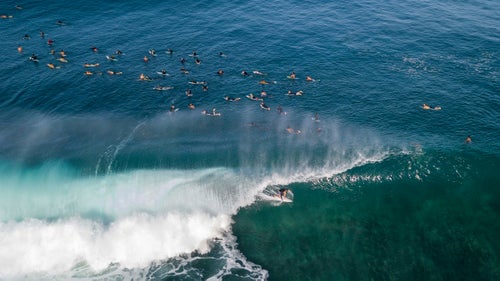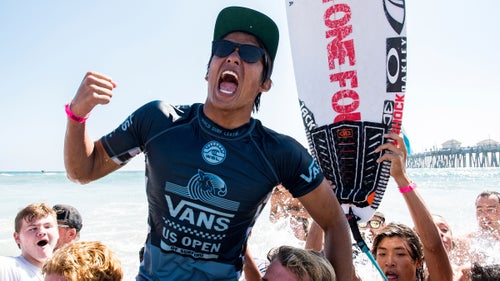Is Kanoa Igarashi the LeBron of Surfing?
Born in Surf City USA, and the descendant of an actual samurai, Japan’s surfing superstar is ready for the sport’s debut on the world stage.
New perk: Easily find new routes and hidden gems, upcoming running events, and more near you. Your weekly Local Running Newsletter has everything you need to lace up! .
Barefoot on the sand among adoring fans at the 2019 Billabong Pipe Masters surf contest on the North Shore of Oahu, Kanoa Igarashi looked mostly like what he was: a smooth-muscled, 22-year-old pro surfer with peroxide-blond hair and the youthful beauty of a boy-band teen idol in a comic book about young rock stars who become space warriors to save the galaxy.
As Igarashi psyched himself up to compete, though, and watched ten-foot barreling blue waves spit great gobs of white foam into the bright Hawaiian sun, he looked like something else, too: a star-kissed man-child who’d already won everything and couldn’t decide how he felt about it.
Allow me to back up. Igarashi has dual Japanese and American citizenship. He grew up in Huntington Beach, California, a.k.a. Surf City, with a Japanese mother and father in the role of hard-driving American sports parents. Igarashi got so good at surfing so fast that in 2016, at just 17 years old, he became the youngest rookie to qualify for the Championship Tour of the World Surf League. He won the , the largest surf competition in the world, in 2017 and 2018, and by early 2019 was the tenth-ranked surfer on earth, the second-ranked American, and absolutely huge in Japan.
That’s really the big story about Igarashi: Japanese pop-cultural superstardom. In 2018, he officially switched his national identity on tour from American to Japanese. His new country has around two million surfers and not a single serious challenger for the title of best and most famous Japanese surfer of all time. As a result, Igarashi, now 23, has had his image plastered on gargantuan billboards in Shibuya Crossing, Tokyo’s equivalent of Times Square. And for several years he has ridden a tsunami of sponsorship money in the neighborhood of $2 million a year from so-called endemic surf brands like Oakley, Quiksilver, and Red Bull, as well as more mainstream outfits like Beats by Dre and Japanese cosmetics and construction companies. Visa has fun ads in which Igarashi quite literally surfs a wave of cash cards.
More recently, Igarashi’s choice of flag has made him the single biggest human-interest story going into surfing’s Olympic debut at the 2020 Tokyo Games. Because, see, Igarashi’s mother and father not only surfed in Japan before moving to the United States but also claim to have moved precisely to give their unborn child the best possible shot at becoming a professional surfer. As if that weren’t awesome enough, Igarashi’s father is pretty sure that he and some friends were the first surfers ever to ride waves at the break in Japan where the Olympic competition will be held, 90 minutes outside Tokyo at Shidashita Beach, in the town of Ichinomiya. Meaning that Igarashi will compete for gold on behalf of family and country at his own father’s home break.
Destiny, anyone?
Nevertheless, on that sunny December day at the 2019 Pipe Masters, Igarashi could have seen his upcoming heat as a very big deal. Pipeline is still the most photographed surf spot on earth, grinding over coral reefs shallow enough to have killed at least 11 surfers and maimed the bodies and egos of countless more. And the Pipe Masters is still the biggest annual event in the sport, the jewel of the globe-trotting nine-event Championship Tour.



